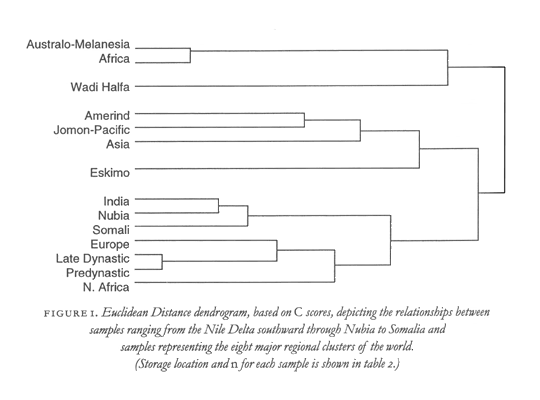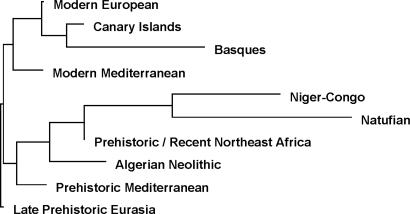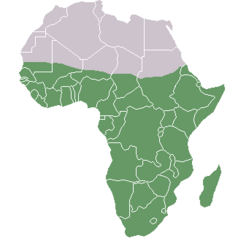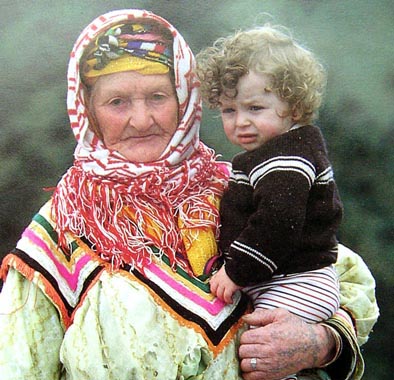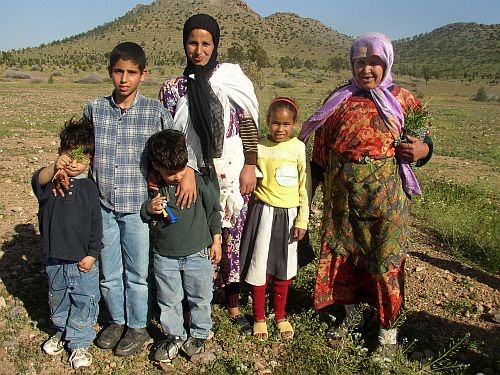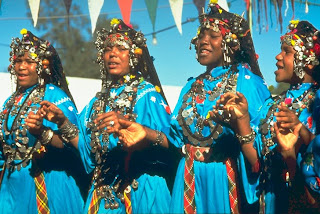Big Triece wrote:Lord Zentei wrote:The conclusions of Brace's 1993 study were not contingent on the assumption that ancient and modern CENTRAL AND NORTHERN Europeans were part of a continuum.
Why are you emphasizing Central and Northern Europeans? What Brace did indeed lump
ALL Europeans both ancient and modern into one giant category under the false presumption that there was no biological distinction between both sets of people.
Incorrect. Look at Fig. 4 in that paper, as well as the conclusion (as cited by CaptainChewbacca, above). As for your question, I emphasized central and northern Europe, because Brace specifically speaks of central and northern Europe when he discusses the groups that exhibited change following the spread the neolithic revolution, as opposed to Mediterranean Europe.
Big Triece wrote:Lord Zentei wrote:Moreover, LIE #2: the passage you cite from the 2005 paper has nothing to do with the 1993 conclusion;
As proven to you time after time after time throughout this thread, the relevance of Brace 06 to the conclusions of his 93 study is the biological affinities of Europeans themselves. The data from Brace 93 concluded that the ancient Egyptians fell into an enormous Caucasoid family along with North Africans, Middle Easterners, Indians, and of course Europeans (with no break down of the last one). The data itself however found that the closest relationship to the Pre-Dynastic samples were Somalis, Pre-historic Europeans, and Indians (the latter discounted by others scholars as an "unlikely match" for several noted reasons).
http://tinypic.com/b7xnrs.jpg
You can see for you fucking self how distant the members of the "Super Caucasoid family" (Modern Euros, Middle Easterners, and North Africans) truly are from the Pre-Dynastic Egyptian sample. If Brace had not used such a vague categorization of Nubian people which even included Medieval samples (after the Islamic conquest) then the Nubians most definitely would have been the closest match (as demonstrated by Godde 2009).
And as you can see from that very chart, Sub-Saharan Africa is far away from either Somalia or Egypt, and Pre-Dynastic Egypt is lot further from Sub-Saharan Africa than Central Europe and North Africa are, so what are you trying to prove with that?

Big Triece wrote:Lord Zentei wrote:And LIE #3: Brace did NOT "lump Europeans together", so your criticism of him is completely baseless. From page 12 of the 1993 study:.....He makes a clear distinction between modern Northwest Europeans and mesolithic Europeans.
Interesting! You were earlier arguing that according to Brace 93' modern Europeans also formed a close tie to Pre-Dynastic Egyptians and you used the dendrogram below as proof:
http://i7.photobucket.com/albums/y259/L ... dw9gmd.gif
While Brace made minor notes that there were distinctions between modern and Pre-historic Euros, he does not reflect these facts in his data as
AS YOU CAN CLEARLY SEE ABOVE! Why is there no modern or Pre-historic separation above? He lumps all European speimens under the same category, which explains how dumbasses like yourself could be willingly mislead to believe that modern Euros shared a close biological affinity with the ancient Egyptians.
Yeah, rather than post sections of his paper, I went with the dendrogram, though I'm pretty sure that you can read that data for yourself. Also, you have been shown the conclusion of the paper. So what the fuck?

Anyhow, just in case you can't see it for some reason, perhaps you prefer this image here:
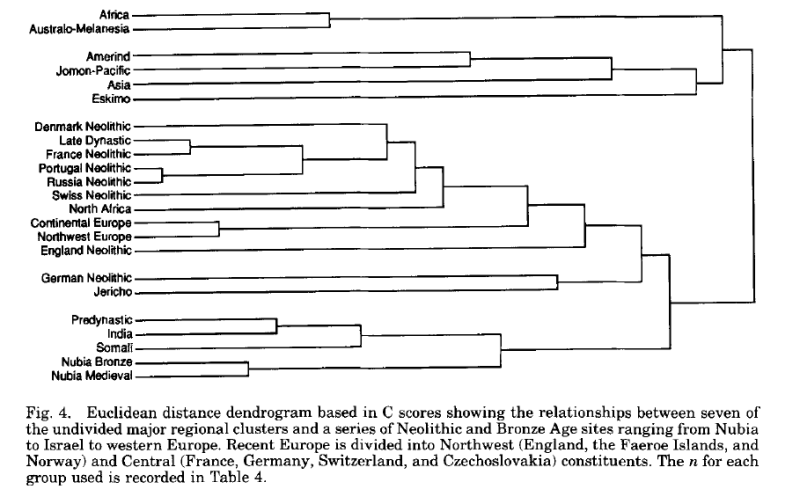
Notice how Predynastic Egypt and Nubia cluster with Europe
both ancient and modern before they cluster with "Africa". Moreover, a distinction is in fact drawn between modern and ancient Europeans.
Big Triece wrote:Lord Zentei wrote:Of course, you understand what INDIRECT affinities are? As has been shown to you before now:
In the context of that quote, it means that while the Natufanians themselves did not originate in "Sub Saharan Africa", the clear Sub Saharan African affinities of these early farmers gives a direct line of affinities to Sub Saharan Africans themselves.
So? It also gives a direct line of affinities to Eurasians. Implying a HETEROGENOUS POPULATION.
Big Triece wrote:Lord Zentei wrote:Implying that there is a LATE prehistoric Eurasian element which is also present of greater importance. I guess the whole "heterogenous population" thing still doesn't sit well with you, does it.
First of all why are you attempting to distort my interpretations of Ricaut 2008 with a quote from Brace 2006? As I've stated earlier, the interpretations of Brace 2006 by Ricaut in his later study are more accurate to the data then Brace's interpretation. Reason being:
http://mathildasanthropologyblog.files. ... .jpg?w=500
From Brace 2006 as you clearly see after the lines are ran together the Natufanians group firmly in between Northeast Africans (Somalis, Nubians, Egyptians) and Niger Congo speakers. Suggesting an absence of a "Eurasian component", which is also never mentioned in Ricuat's 2008 interpretations or his own data.
It is no "misrepresentation". It clearly speaks of a Eurasian component. And if you're thinking about hte Ricuat study I think you're talking about, then it had this to say:
Ricaut wrote:Results
MMD^sub st^ values calculated from 17 nonmetric traits between Sagalassos and the 27 Eurasian populations are provided in Table 3. The matrix of MMD^sub st^ values between each pair of populations is not shown because of its unwieldy size (data available on request from the authors).
An examination of the biodistances (Table 3) shows that the Sagalassos population is more similar to West Eurasian and ancient northeast African populations than to Central and East Eurasian populations. The closest populations to Sagalassos are from Greece, Cyprus and Turkey, Germany, and Scandinavia, followed by the other European and ancient northeast African (ancient Egyptian and Sudanese) populations and then by the Central and East Eurasians and the sub-Saharan Tanzanian population. Intriguingly, the closeness of the Sagalassos population to Germans and Scandinavians was unexpected, but more surprising and less obviously explainable were the MMD^sub st^ values from Gabon and Somalia, which show some similarity with the Sagalassos population, yet the MMD^sub st^ scores are nearly significant (Gabon, 1.93; and Somalia, 1.68; see Table 3).
The MDS representation of the global data set of 28 populations (Figure 2) shows roughly three main population clusters: (1) Central, Northeast, and East Eurasian populations, which are found in the top left; (2) West Eurasian and ancient Egyptian and Sudanese populations in the lower part; and (3) recent sub-Saharan populations in the top right. The Sagalassos population clusters with the second group and is most closely related to Greek, Cypriot/Turkish, and Scandinavian populations.
The dendrogram produced by Ward's clustering procedure for the global data set is shown in Figure 3 and provides a relatively similar representation of the MMD^sub st^ distance matrix than that provide by the MDS analysis. The populations clearly fall into two groups. The first main group can be broken down into two subgroups: (1) all the recent sub-Saharan populations and (2) mainly Central, East, and Northeast Eurasians. West Eurasians form the second main group, which is also subdivided into two subgroups. One of these subgroups includes all the eastern Mediterranean populations (three ancient Egyptian/Sudanese populations from Naqada, Gizeh, and Kerma as well as the Cypriot/Turkish, Greek, and Sagalassian populations) and the Scandinavian sample; the second subgroup includes the other West Eurasian populations.
Look familiar? Can it be that you have seen it before now?  And no doubt you're still claiming that all Ward's dendrogram does is show that the population has somehow changed over time, even though Irish (2006) amongst others explicitly says that it didn't. Yet even though you reject the implications of this passage from the Ricault's study as well as Irish, you still insist on quoting them whenever it's convenient.
And no doubt you're still claiming that all Ward's dendrogram does is show that the population has somehow changed over time, even though Irish (2006) amongst others explicitly says that it didn't. Yet even though you reject the implications of this passage from the Ricault's study as well as Irish, you still insist on quoting them whenever it's convenient.  Your penchant for using studies that disagree with you is highly perplexing and moreover annoying, especially when you then turn around and say that they don't count when they don't support you any more.
Your penchant for using studies that disagree with you is highly perplexing and moreover annoying, especially when you then turn around and say that they don't count when they don't support you any more.
Big Triece wrote:Lord Zentei wrote:The point of the matter is that there's a difference between mass-reduced teeth and mass additive ones, the latter being typical of Sub-Saharan populations.
Yes there is in fact a difference between the tooth size of Nile Valley inhabitants and those populations further south, but as shown to you it was not due to some mass influx of "Caucasoids" into the Nile, but rather an adaption to new agricultural practices.
The point escapes you. The point that mass additive teeth are not the same as mass reduced ones is not refuted by merely saying that local in-situ evolution took place.
Incidentally, in-situ evolution does not necessarily support your position in any case:
Linka.
Larsen wrote:Beginning in the nineteenth century, various workers speculated on the origins of human groups occupying the [Nile Valley]. Following Morton's (1844) highly influential study of archaeological crania from Egypt and Nubia, the prevailing notion was that two biologically distinct groups occupied the Nile Valley in temporal succession. In Lower Nubia, Morant (1925) identified an earlier 'Upper Nile type', with predominantly 'Negroid' features, and a later 'Lower Nile type', which lacked 'Negroid' features. The changes were viewed in a diffusionistic paradigm: simply, the disappearance of 'Negroid' features resulted from an invasion and subsequent replacement by alien 'Caucasoid' (Egyptian) peoples from the north.
Recent analyses of crania and dentitions from lower Nubia indicate that the evidence for the diffusionist model of biological change is less than compelling. Independent analyses of skeletal and dental discrete and metric variables and other lines of evidence suggest that the earlier and later Nubian populations represent a biological continuum with no invasion by nonindigenous populations. Therefore, the differences in cranial morphology between earlier and later populations...are best understood in relation to factors not involving population replacement.
For better understanding of these factors, especially those related to dietary and technological change, Carlson and Van Gerven and their coworkers compared craniofacial morphology in a Nubian-based temporal sequence, including foragers from the Mesolithic (ca. 12,000 BP), initial agriculturalists from the combined A- and C-groups (3400-1200 BC), and intensive agriculturalists from the combined Meroitic, X-group, and Christian horizons (AD 0-1500). These comparisons reveal that Nubian foragers and incipient agriculturalists have flat and elongated vaults with well-developed, protruding supraorbital tori and occipitals. In contrast, later intensive agriculturalists have rounded vaults with small and more posteriorly positioned faces and masticatory muscle attachment site (temporalis and masseter) and reduced temporomandibular joint size.
Carlson and co-workers posit a masticatory-functional hypothesis for explaining craniofacial changes in Nubia. They argue that the primary factor influencing Nubian craniofacial anatomy was the change in subsistence economy, from foraging to food production and the shift to consumption of softer foods. These changes resulted in a reduction in activity of the masticatory muscles and a concomitant decrease in mechanical loading of the craniofacial skeleton. Alteration in masticatory function led to alteration in craniofacial growth in two ways, including (1) decreased stimulation of bone growth, leading to a reduction in facial robusticity; and (2) progressive alteration of the overall growth of the face and vault, resulting in a smaller and more inferoposteriorly oriented face relative to the cranial vault.
[...]
Turner and coworkers reassessed Greene and coworkers' continuity model of Nubian population history. Although lauding the studies of Greene and others for using a nonracial, nontypological approach to Nubian population history, they argue that extra-regional sources of variation have been insufficiently considered, especially sources that may explain temporal shifts in craniofacial morphology in this region. Implicit in the work by Greene and others is the assumption that population continuity extends at least as far back as the late Pleistocene (ca. 12,000 BP). Turner and coworkers contend that continuity can be claimed only if non-Nubian populations are also considered in statistical analyses of dental trait variation in this region.
Turner and coworkers include in their analysis additional Nubian dentitions from the late Pleistocene 'Upper Stone Age', Meroitic, X-group, Christian period, and historic era European samples. Computed MMD values, modified for small samples and tested for significance, reveal few significant differences between Meroitic, X-group and Christian periods, thus confirming Greene's earlier conclusions regarding population continuity. However, significant differences between the Pleistocene and later groups were clearly identified.... Because of the apparent temporal discontinuity between the Pleistocene and later populations, Turner & Markowitz (1990) hypothesize that the ancestry of recent Nubians was not derived from local late Pleistocene populations, and that a population replacement event occurred during the Holocene in Nubia. The origin of these later populations is unclear, but, solely on the basis of dental traits, they argue that populations north of Nubia containing European and Near Eastern traits are the most likely sources.
In an effort to identify other possible sources of variation, Irish & Turner (1990) compared their sample of Nubian dentitions (late Pleistocene to Christian period) to historic-period dentitions from a west African group — the Ashanti. Univariate and MMD statistical treatment of these samples reveal strong similarities between modern west Africans and late Pleistocene Nubians. As with previous studies, later Holocene dentitions were found to be very similar. The late Pleistocene and modern west Africans are strongly divergent from the Meroitic, X-group, and Christian period Nubians. Therefore, the authors argue that there is a population discontinuity between the late Pleistocene and Holocene populations in Nubia, with the former sharing biological affinities with west Africans. Irish & Turner (1990) suggest that the discontinuity can be explained by high rates of violence and decline (or possible extinction) in late Pleistocene (Mesolithic) Nubian forager, which may have left them susceptible to invasion or 'genetic swapping' by other groups from west Africa.
Turner and coworkers' findings are intriguing, but their analyses do not necessarily disprove the continuity model for the Pleistocene to Holocene transition. Especially problematic is the virtual lack of data from the period between the A-group and the Mesolithic, which represents nearly four millennia of occupation of the region. Comparisons of Mesolithic and A-group populations reveal a decrease in craniofacial robusticity and dental complexity. To be sure, the agent of change could have been gene flow from some other region. Additional dental and morphological data, and a more substantial treatment of the archaeological context from regions surrounding Nubia, are required before the discontinuity model can be accepted. Moreover, the west African collection used for identifying dental trait frequencies is largely undocumented. Therefore, although the similarities between late Pleistocene and west African dental traits are interesting, they are not compelling. From the preponderance of evidence from other studies of craniofacial morphology, biological change, and population history, a model of population continuity appears to fit the evidence best.
Moral of the story: in-situ evolution can just as easily account for the opposing viewpoint. And that is why the difference between mass-additive teeth and mass-reduced teeth is significant: despite the changes caused by evolution in response to changed lifestyles, traces of the past remain.
Big Triece wrote:Lord Zentei wrote:The fact that the Egyptians were tropically adapted, and had locally evolved teeth does not mean that they are closely related to Sub-Saharan populations in general.
So then what makes the ancient Egyptians close to Sub Saharan African populations? Could it be that they have a genetic basis in Sub Saharan Africa? Could it be that their phenotype according to cranial and skeletal analysis is consistent with that of populations in (Sudanese) and south of the Sahara? Could it be that their language family originated in a region south of the Sahara? Or is it the fact that there culture directly stems from African cultures which are seen in or south of the Sahara?
Just give the fuck up!
Just wow.

Big Triece wrote:Lord Zentei wrote:Seemingly, plain English escapes you. Except that this is more likely LIE #5. I just can't fathom how you can go around making such ridiculous claims when your own sources say stuff like this:....Emphasis mine. And so much for that.
What the fuck is wrong with you! You waited two fucking weeks to rehash the same fucking debunked arguments. This has already been addressed to you in this thread. The very quote that are citing was written in the study
BEFORE the samples were combined. This is what he wrote from the results of such:
The Niger-Congo speakers (Congo, Dahomey, and Haya) cluster closely with each other and a bit less closely with the Nubian sample (both the recent and the Bronze Age Nubians) and more remotely with the Naqada Bronze Age sample of
Egypt, the modern Somalis, and the Arabic-speaking Fellaheen (farmers) of Israel. When those samples are separated and run in a single analysis as in Fig. 1, there clearly is a tie between them that is diluted the farther one gets from Sub-Saharan Africa.
Link
These are again what Brace wrote
AFTER the samples were
COMBINED. You are deliberately trying to distort this study by passing off premature conclusions as the end result (and though other ways).
You had only "debunked" it in your distorted imagination. And what does your quote have to do with the quote I presented? Who is denying that any connection exists at all? Do you still not understand what is meant by "heterogenous"?
Big Triece wrote:Lord Zentei wrote:Yeah, except that since limb proportions are adaptions to the intensity of solar radiation and are functions of such throughout the world
Yes and skin color is also an adaption to the intensity of solar radiation. That is why according to ecological principal dark skin accompanies populations who are tropically adapted. The ancient Egyptians were tropically adapted in the same fashion as tropical Africans, which means that they would have also had dark skin within the range of tropical African populations.
Does not follow, neither does their relationship.
Big Triece wrote:Lord Zentei wrote:- the implications are that they do NOTHING to prove relationship between such groups.
When have I stated that this adaptive traits proves a relationship between populations? This fact has only been used to denote
PHENOTYPE (
WHAT THEY LOOKED LIKE)! Other tropically adapted populations are the South/Southeast Asians and aboriginal Australians. Aside from skin tones which have been used to label all of the populations "black" or even "Negroes" (in their own respect), they are genetically distinct from tropical Africans.
So what have you been yammering about this whole time? You have consistently claimed close relationship between the pre-Dynastic Egyptians and other Sub-Saharan populations, and now you post this? Are you agreeing now that the Ancient Egyptians were NOT related to sub-Saharan populations in general? Oy.
Incidentally, on the topic of phenotypes and their implications (page 189):
Michelle H. Raxter (2011) wrote:Egyptian Body Plan:
Ecogeographic Patterns in a Middle Latitude Population and Egypt at the Intersection of Continents Based on ecogeographic rules, Egypt‟s warmer climate relative to higher latitude populations should select for bodies with comparatively narrower body breadths and longer limbs. Nubia‟s lower latitude and location closer to Sub-Saharan Africa should be manifested in individuals possessing a more tropical body plan relative to individuals in Egypt proper. The present study found results consistent with the above expectations, with Egyptians possessing a more tropical body plan compared to higher latitude populations, and Nubians generally exhibiting more linear bodies compared to Egyptians.
More specifically, Nubians have more tropically adapted leg lengths (longer tibiae relative to their femurs) compared to Egyptians. When plotted, ancient Egyptians and Nubians of both sexes generally exhibit intermediate values between higher latitude and lower latitude populations for bi-iliac breadth (LBIB), body mass (BM), and surface area to body mass (SA/BM). This is similar to what Holliday (1995) found for his North African sample (also composed of ancient Egyptians and Nubians). When examining specific Northeast African regions, Upper Egyptians and Upper Nubians tend to possess more linear body plans compared to Lower Egyptians, a pattern that is also consistent with ecogeographic expectations.
The fact that limb proportions in ancient Egyptians are somewhat more “tropical” may reflect the greater lability of limb length compared to body breadth. The results may also suggest that Egyptians are closely related to circum-Mediterranean and/or Near
Eastern groups and have retained those body breadths acquired earlier in time, but quickly developed limb length proportions more suited to their present very hot environments. The present results for bi-iliac breadth are also consistent with various genetic studies that have found modern Egyptians to have close affinities to Middle and Near Easterners (Manni et al., 2002; Arredi et al., 2004; Shepard and Herrera, 2006; Rowold et al., 2007) and Southern Europeans/Mediterranean groups (Capelli et al., 2006). Some of these authors suggested their results may have been associated with a diffusion from the Near East during the expansion of early food-producing societies (Arredi et al., 2004; Rowold et al., 2007).
Shepard and Herrera‟s (2006) study of autosomes specifically found Egypt and the Sudan forming a tight cluster with other Southwest Asian groups (Yemen, Jordan, Oman, Bahrain) and occupied an intermediate position to Sub-Saharan African (Kenya
and Rwanda) and Eastern Asian groups (Pakistan).in their study‟s sample. A study of classical genetic markers showed that Egyptians appeared to have a mixture of African, Asian, and Arabian characteristics (Mahmoud et al., 1987). Another study found close affinities between Egyptians and specifically eastern Sub-Saharan groups , suggesting to the authors that the Nile may have been used as a migratory passageway (Terreros et al., 2005). This evidence demonstrates the adaptive and historical influences of Egypt‟s mid-latitude position as well as proximity to eastern Sub-Saharan Africa, Southwest Asia and Southern Europe.
And from the Conclusions section of that study (page 192):
Ancient Egyptians as a whole generally exhibit intermediate body breadths relative to higher and lower latitude populations, with Lower Egyptians possessing wider body breadths, as well as lower brachial and crural indices, compared to Upper Egyptians and
Upper Nubians. This may suggest that Egyptians are closely related to circum-Mediterranean and/or Near Eastern groups, but quickly developed limb length proportions more suited to their present very hot environments These results may also reflect the greater plasticity of limb length compared to body breadth.
So. Comments?
Big Triece wrote:Lord Zentei wrote:Naturally, you simply assumed that this meant identity. Presumably you also assume that Australian aboriginals are Sub-Saharan Africans too.


Look at the how much of an ass you are making yourself out to be just to avoid conceding to the clear fact that the ancient Egyptians were black Africans.
Right, so no rebuttal? Excellent, moving right along...
Big Triece wrote:Lord Zentei wrote:Seeing as you're fond of claiming that newer studies refute older ones, that study is refuted by Loring Brace.

From Brace 1993:
"In this regard it is interesting to note that limb proportions of Predynastic Naqada people in Upper Egypt are reported to be "Super-Negroid," meaning that the distal segments are elongated in the fashion of tropical Africans.....skin color intensification and distal limb elongation are apparent wherever people have been long-term residents of the tropics."
Just stop it..smh!
Right, and were you the one presuming to accuse others of making dishonest quotes earlier? Yes, I believe so. How fascinating.

Brace 1993 wrote:In this regard, it is interesting to note that the limb proportions of the Predynastic Naqada people in Upper Egypt are reported to be “super-negroid,” meaning that the distal segments are elongated in the fashion of tropical Africans (Robins and Shute, 1986). It would be just as accurate to call them “super-Veddoid or “super-Carpentarian” since skin color intensification and distal limb elongation is apparent wherever people have been long-term residents of the tropics. The term “supertropical” would be better since it implies the results of selection associated with a given latitude rather than the more “racially loaded” term “negroid.”
Yup.




